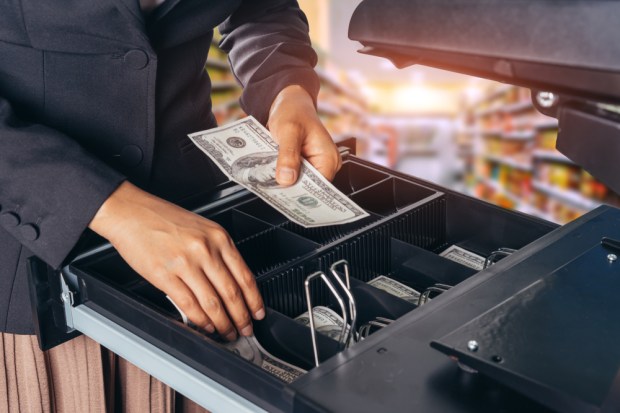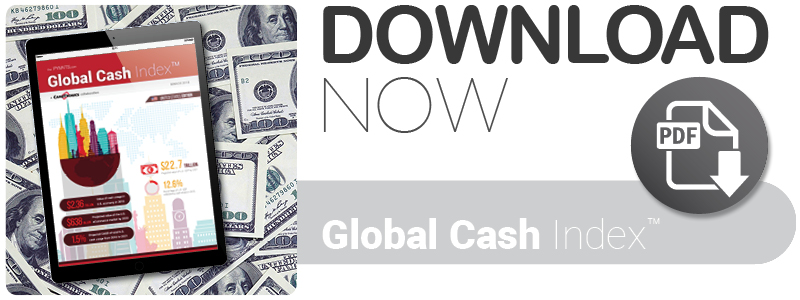Cash Is Still On Top For US Consumers

In the U.S., cash isn’t just sticking around — at $2.3T in overall spend, it remains the most commonly used payment method among consumers. The latest Global Cash Index examines more than 240 data points to gauge the factors powering cash’s projected growth in the U.S. and its place in the ever-more-digital retail market. Plus, an interview with Claire Greene, payment risk analyst for the Federal Reserve Bank of Atlanta, on U.S. consumers’ changing cash habits.
Despite new payment methods and innovations promising to render physical currency a thing of the past, American consumers still appear keen to keep cash on hand.
The rideshare market’s appeal, for example, is based on its promise to enable payments to be seamlessly blended with a digitally facilitated service. Cash is still in demand, though, even in a mobile market where rides are both summoned and paid for with the tap of a smartphone. In fact, newer rideshare services like Curb and DashRabbit are turning to cash to attract customers who would rather not use cards.
According to data from the Federal Reserve Bank of San Francisco, even if more than half of all transportation services in the U.S. converted to ridesharing apps, cash transactions would only decline by 1.4 percent. This suggests that though these services were originally geared toward digital payment, they are failing to make a dent in cash’s dominance.
Many other sectors in the broader economy are happy to accept hard currency, too. Recent results of Federal Reserve Bank of Boston’s research indicate that among U.S. consumers, cash is the most commonly used payment method for daily expenditures.
To gain a better perspective on how U.S. consumers use cash, PYMNTS recently spoke with Claire Greene, payments risk expert for the Federal Reserve Bank of Atlanta — and former payments analyst for the Federal Reserve Bank of Boston — about what the Fed has learned about U.S. consumers’ cash habits.
U.S. consumers (still) love cash
Cash has far outpaced the use of other payment methods in everyday consumer spending, according to data in the Boston Fed’s “2016 Diary of Consumer Payment Choice (DCPC)” study.
The survey asked participants about their payment habits during October 2016, finding more than 30 percent of consumers made payments with cash, 27 percent paid with debit cards and only 18 percent paid with credit cards. The results indicated cash is not only going strong, but is also outperforming other payment methods in everyday use.
Though a breakdown of the specific payments consumers made with cash was unavailable, Greene said they clearly preferred cash when making lower value transactions.
“When we asked consumers what they prefer to use for an in-person purchase by dollar value, two-thirds of [them] said they like to use cash for a payment of $10 or less,” she said. “About 40 percent of consumers say they prefer cash for payments of about $10 to $25.”
The Fed’s report does not ask what they are purchasing, but Greene noted consumers might be choosing to pay with cash to protect their privacy. A lack of digital breadcrumbs is a win for some. As an example, she noted a consumer might use cash to purchase a candy bar after lunch, allowing him to enjoy the sugary indulgence without leaving an electronic trail to remind him about it and induce guilt later.
“When you look at security ratings for cash, some [consumers] will rate it as very secure,” Greene said. “Think about the anonymity of transactions and the fact that you aren’t providing any personal data by making that transaction.”
Not everyone is convinced, however.
“Other consumers will rate cash as quite insecure because, of course, you can drop it on the sidewalk and it’s gone,” she said.
Cash bridges generational divides
Recent data from the Federal Reserve Bank of San Francisco revealed cash is not only a widely popular method of payment among U.S. consumers, but also increasingly in popularity.
Cash is the top choice compared to other payment methods for older generations. Early findings from the San Francisco Fed’s DCPC report found consumers ages 35 and older consider cash their top payment preference. It also found 31 percent of consumers aged 35 to 44 prefer cash to debit cards, credit cards, checks, electronic payments and other payment options, and that 33 percent of consumers in both the 45 to 54 and 65 and older brackets preferred cash over other options.
Though younger consumers have a reputation for preferring all things digital, data shows they regularly use cash. The San Francisco Fed report noted cash is the second most popular payment option among consumers aged 18 to 24 and 25 to 34. Debit cards were the most popular, and electronic payments, on the other hand, saw much lower usage rates among these groups.
According to Greene, the Fed has been asking consumers about their financial habits since 2008. Consumers have consistently said they are not ready to retire cash, despite the wide availability of newer payment options.
“Consumers rate cash highly for convenience, cost, set up and acceptance for payment,” she said. “Research shows that these ratings are a factor in payment instrument choice [for] both adoption and use. So, that gives you a clue that cash is very much alive.”

